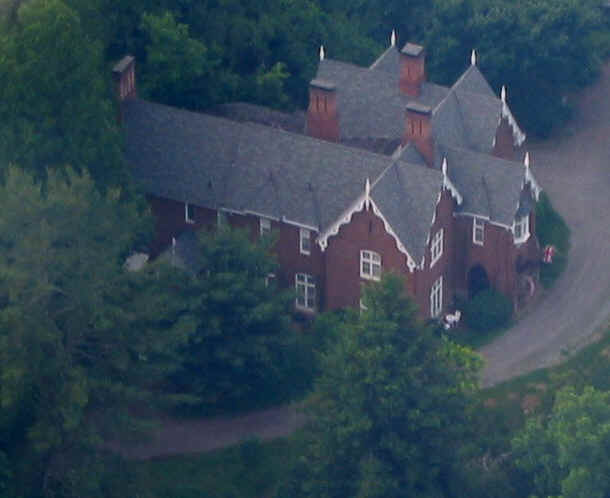
|
Milton Hall Built in 1874 Virginia Historic Landmark National Register of Historic Places |
History
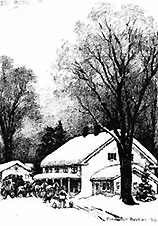 Milton Hall has been a refuge from the very beginning.
Nestled against the Eastern
slope of the Alleghany Mountains and encircled by cold
mountain streams, the
area now known as Callaghan has attracted people seeking the
solace of
the great outdoors since the eighteenth century.
Milton Hall has been a refuge from the very beginning.
Nestled against the Eastern
slope of the Alleghany Mountains and encircled by cold
mountain streams, the
area now known as Callaghan has attracted people seeking the
solace of
the great outdoors since the eighteenth century.
Dennis Callaghan, a Revolutionary War veteran and Irish expatriate, settled in Bath County about 1790 in the shadow of Oliver Mountain, which he named for his son. He and his wife Margaret opened the renowned Callaghan Tavern in 1792 offering food and lodging to travelers on the Staunton and Kanawha Turnpike. Travelers on the Great Road destined for the Kentucky and Ohio territories crossed Dunlap Creek only to be greeted by the heavenly aroma of fresh biscuits and fried chicken and a spunky little Irishman. Decked out in a swing-tail coat with buttons as big as a pewter plate, and voluminous knee length breeches covering heavy woolen stockings, Dennis Callaghan's hospitality was known far and wide and survives in the written recollections of many western travelers.
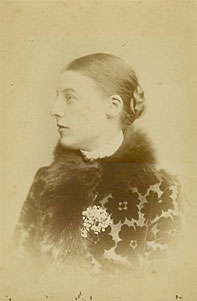 At about the same time Dennis' wife, Margaret (reportedly a
lineal
descendent of Pocahontas) was laid to rest in Callaghan,
Laura Maria Theresa Beauclerk,
a little girl of privilege, was born a world away. A
descendant of Charles II and his mistress
Nell Gywnne, she would marry into one of the richest, most
powerful families in England,
only to seek asylum in the United States when her husband's
unspeakable illness made her comfortable aristocratic life
untenable.
At about the same time Dennis' wife, Margaret (reportedly a
lineal
descendent of Pocahontas) was laid to rest in Callaghan,
Laura Maria Theresa Beauclerk,
a little girl of privilege, was born a world away. A
descendant of Charles II and his mistress
Nell Gywnne, she would marry into one of the richest, most
powerful families in England,
only to seek asylum in the United States when her husband's
unspeakable illness made her comfortable aristocratic life
untenable.
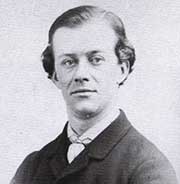 At
eighteen, Laura married William Wentworth Fitzwilliam, the Viscount
Milton, and oldest son of the 6th Earl Fitzwilliam. The Fitzwilliams
trace their lineage to William, son of Godric, a medieval nobleman.
Viscount Milton, acclaimed for his book "Northwest Passage by Land"
recounting his daring trek across Canada in the 1860s, had epilepsy.
Despite this, he was elected to Parliament and feted throughout
England for his daring Canadian exploits. Their marriage was a grand
affair. The bride was attended by twelve bridesmaids and given away
by her uncle, Sir Montague Cholmely, MP. The new Vicountess and her
husband were welcomed at the Fitzwilliam family estate,
Wentworth-Woodhouse in Yorkshire, the largest private home in
England. Lady Milton was understandably proud of her wedding ring
personally fashioned by her new husband from gold he'd acquired in
British Columbia.
At
eighteen, Laura married William Wentworth Fitzwilliam, the Viscount
Milton, and oldest son of the 6th Earl Fitzwilliam. The Fitzwilliams
trace their lineage to William, son of Godric, a medieval nobleman.
Viscount Milton, acclaimed for his book "Northwest Passage by Land"
recounting his daring trek across Canada in the 1860s, had epilepsy.
Despite this, he was elected to Parliament and feted throughout
England for his daring Canadian exploits. Their marriage was a grand
affair. The bride was attended by twelve bridesmaids and given away
by her uncle, Sir Montague Cholmely, MP. The new Vicountess and her
husband were welcomed at the Fitzwilliam family estate,
Wentworth-Woodhouse in Yorkshire, the largest private home in
England. Lady Milton was understandably proud of her wedding ring
personally fashioned by her new husband from gold he'd acquired in
British Columbia.
Viscount Milton's stint in Parliament ended abruptly in 1872 when his epilepsy worsened. A pregnant Lady Milton, her stricken husband and their two very young children left England and prying aristocratic eyes for the United States. Accompanied by Dr. Miller and a nurse, they spent a short time in New York then continued on to Fort Williams, Ontario for the birth on English soil of Viscount Milton's only son and future 7th Earl Fitzwilliam. They left Canada and traveled to Virginia, according to a journal kept by Matilda Count, the nurse who accompanied the family. Viscount and Lady Milton purchased Callaghan Tavern in 1872 possibly in response to the glorious reports sent by Lady Milton's older brother, who had been in the United States since the Civil War. Local lore suggests that Lady Milton was looking for a quiet area of respite for her afflicted husband. The entourage of at least twenty-one family members and servants moved into the ancient wooden tavern just before Christmas of 1873 and, by the New Year, they were homeless.
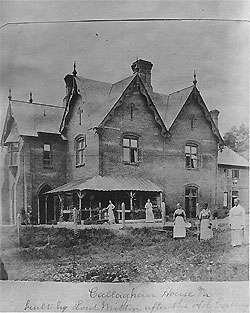 Holiday festivities included
fireworks. The building caught fire and the wooden tavern burned
quickly, leaving little time for the family to escape. Though
initially all escaped safely, a nineteen-year-old servant girl named
Eliza Jane ran back in to recover Lady Milton's jewelry and was
overcome by the conflagration. Her tombstone can be found in the
Callaghan cemetery on a hill above the site of the old tavern. The
family spent the winter in Staunton. While in Staunton Lady Milton,
it is said, met fellow Englishman William Abbott Pratt, a renowned
architect whose specialty was gothic revival architecture. Though at
the end of his illustrious career, Mr. Pratt may have been touched
by Lady Milton's situation. In addition to all the tragedy, she had
been living in someone else's home since she was ten. She needed a
home to call her own.
Holiday festivities included
fireworks. The building caught fire and the wooden tavern burned
quickly, leaving little time for the family to escape. Though
initially all escaped safely, a nineteen-year-old servant girl named
Eliza Jane ran back in to recover Lady Milton's jewelry and was
overcome by the conflagration. Her tombstone can be found in the
Callaghan cemetery on a hill above the site of the old tavern. The
family spent the winter in Staunton. While in Staunton Lady Milton,
it is said, met fellow Englishman William Abbott Pratt, a renowned
architect whose specialty was gothic revival architecture. Though at
the end of his illustrious career, Mr. Pratt may have been touched
by Lady Milton's situation. In addition to all the tragedy, she had
been living in someone else's home since she was ten. She needed a
home to call her own.
No records exist to support William Pratt as Lady Milton's architect, but Laura's first real home, Milton Hall, looks like nothing else in the Alleghany Highlands. It was built facing Johnson's Creek; a hot spring provided year round healing waters for the family. Brick was made on the nearby Marshall farm and the glass was made on site. Six-foot windows on two floors took advantage of cool breezes off the mountain, and brought light into every room even on the darkest winter days. A small army of servants, carrying endless buckets of coke, tended the thirteen fireplaces. Grand decorative bargeboards were hewn from massive local yellow pine trees. Interior decorations, mantels and furniture were ordered from England. Though gothic revival architecture was no longer in vogue in the United States, Lady Milton was probably thoroughly pleased with her country estate. The wild, game laden forests surrounding Callaghan gave them a little touch of England in the middle of Alleghany County.
The couple entertained many European
guests and probably visited other acquaintances at the Homestead
Resort, only a carriage ride away. Their happiness was short lived.
In 1877, Viscount Milton died at the age of 38 in Rouen, France.
Lady Milton visited Callaghan House, her "first" home, one last time
in the 1880s before her own untimely death in 1886. In her last will
and testament, Laura (a copy of her will is recorded at the
Alleghany County Court house) left her home to her sisters Blanche
and Vilunza. Herbert Beauclerk, Laura's brother, lived in the house
for a time until he moved to Hot Springs, Virginia where he became
one of America's first golf pros. Lady Milton's gothic country house
was put on the auction block in 1888.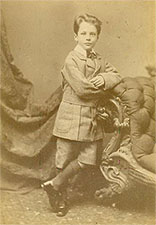
Laura's son William Charles de Meron Fitzwilliam, who once played on the wide central staircase, assumed the title of 7th Earl Fitzwilliam in 1910. His son, the 8th Earl, served with distinction in WWII and died in a plane crash in 1948 with President Kennedy's oldest sister. Englishman Captain Henry Rumbold had been an enthusiastic guest of the Fitzwilliams in the 1870s. He loved hunting and fishing and was no doubt looking for a place to get away from it all in his golden years. No one knows how he found out the property was for sale, but in 1889 the 62 year-old Crimean War Veteran bought it. At one point, his daughter drew plans to utilize Milton Hall as a boarding school for girls. That dream never materialized. One of his last requests was to be interred near his home in Callaghan. Of his four children only Cumberland remained in the area following his father's death in 1911. It was Cumberland's widow Ethel who sold a portion of the original 160 acres, including Wood Hall, to Hugh McAllister in 1926.
Hugh McAllister's family had been instrumental in making Alleghany County and Covington, in particular, a commercial center in the Western Highlands. Hugh felt his growing family could use a place to escape the summer heat in Covington. He was certainly aware of the historic importance of what was now known as Milton Hall, for Mr. McAllister was an expert on local history. His vast library graced many bookcases of Milton Hall until his death in 1961. Hugh brought the first electricity to Callaghan. He electrified the house and added a coal-fired boiler for steam heat. Johnson's Creek was dammed in the summer for swimming and ice-skating in the winter. Birthday parties, billiards competitions and weddings kept the place humming for almost 40 years. The McAllister children and grandchildren still recount the happy times spent at Milton Hall during their family reunions each August.
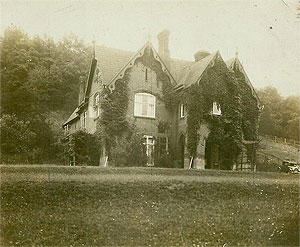 Following the McAllister years the
house endured some hard times. Milton Hall remained a family
dwelling but few improvements were made until the property was
conveyed to William and Mary Dowdy in 1980. Mary Dowdy had a vision
for Milton Hall that included a formal English garden, a modernized
kitchen and a complete interior face-lift. It took ten years, but
Mary single handedly brought Milton Hall into the modern age. She
applied for and received both Virginia and National Historic
Landmark status for the property and was the first to begin tours
for community groups emphasizing the historic importance of Milton
Hall in the legend and lore of Alleghany County.
Following the McAllister years the
house endured some hard times. Milton Hall remained a family
dwelling but few improvements were made until the property was
conveyed to William and Mary Dowdy in 1980. Mary Dowdy had a vision
for Milton Hall that included a formal English garden, a modernized
kitchen and a complete interior face-lift. It took ten years, but
Mary single handedly brought Milton Hall into the modern age. She
applied for and received both Virginia and National Historic
Landmark status for the property and was the first to begin tours
for community groups emphasizing the historic importance of Milton
Hall in the legend and lore of Alleghany County.
In 1990 Milton Hall was opened as a bed and breakfast, but still maintained the feeling of a family home. In 1998, a new roof, restoration of the exterior ornaments and bargeboards, new furnace and air conditioning brought this beautiful nineteenth century estate safely into the twenty-first century.
In April, 2007, Milton Hall was sold and the inn was closed. The new owners, Edward Loiseau
and Floyd Harrison started restorations in an attempt to return the grand royal family feel
to the manor. The bathroom under the arch between the old billiard room and music parlor was
removed and the gothic arch exposed as it was originally. The billiard room now has an ornate
pool table and the music parlor has a restored 1912 Mehlin & Sons 6'2" Patent grand piano. A twenty
by fifty foot all-concrete swimming pool was built between the English garden and the manor.
The Current Owners
|
Milton Hall |